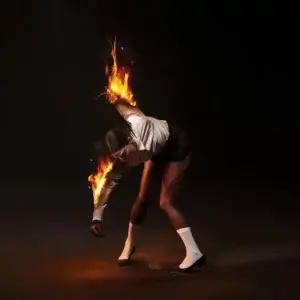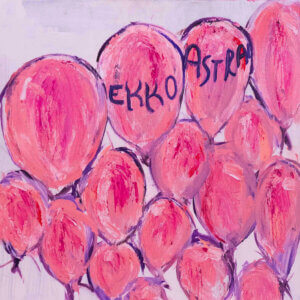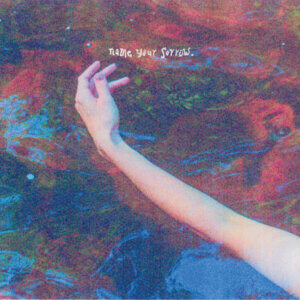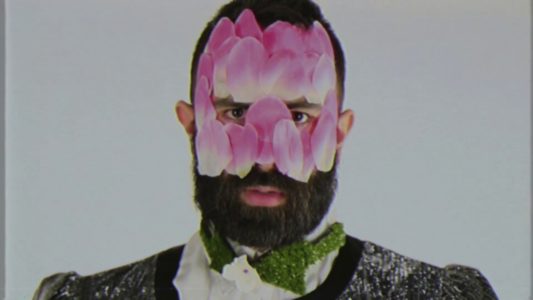The Glambient Glory of The Golden Age of Wrestling

Masked grapplers of yore held their identities close to the chest during the golden age of wrestling, keeping kayfabe at all costs. The identity of Vancouver electronic artist The Golden Age of Wrestling, meanwhile, isn’t exactly a trade secret. True, every promo photo of the artist finds their face obscured by the goldust glitter of a sequined cape, but it doesn’t take much Instagram sleuthing to figure out who they are. The Golden Age of Wrestling is, in fact, the latest musical venture for Jeff Cancade, who has spent the past half-decade producing achingly personal electro-pop under the guise of Devours. Running with the theme, Cancade’s new release is titled Tombstone Piledriver, referencing the cranium-collapsing finishing move of longtime wrestling phenom the Undertaker. Despite this, the music is delivered with a pleasantly soft touch, a near instrumental collection that finds the perfect nexus point between bleep-heavy video game scores, the Seiko watch jingles of Japanese composer Yasuaki Shimizu, and the New Age glossolalia of Enya. All that and more, it’s full of jubilant overworld SNES-scapes (“Koopa Troopa Bleach”), sun-warped synth-bop (“Goth Roulette”), and nightcrawling creep-outs (“Ascension”).
Cancade took on a call with Northern Transmissions from his Vancouver home to discuss how ‘90s WCW, Gregorian electronica, and youthful nostalgia helped usher in the Golden Age of Wrestling.
This interview has been edited and condensed.
Northern Transmissions: How’s your morning been?
Jeff Cancade: It’s good! I’m working, but taking a break for this—there’s no rush. I have a job for one more month, video editing a kids cartoon called 44 Cats. The company I’m working for is called Bardel Entertainment; they’re a big animation studio in Vancouver. I’ve been doing video editing on animatics and storyboards for the past year.
NT: What other shows have you worked on?
JC: In the past I’ve done music editing for cartoons—Cloudy with a Chance of Meatballs, Littlest Pet Shop—but this is my first foray into video editing. I was struggling to find music editing work these past few years, but I managed to find a little video editing gig. I’m grateful to have had something these past few months during COVID-19.
NT: Presumably you’re now familiar with all 44 of these cats. Are you finding that you relate to any of them in particular?
JC: There’s one cat that’s kind of a bad cat [laughs]. He’s the villain; he wears a leather jacket. His name is Boss, and he’s always trying to screw over the other cats. Hopefully I’m not that person in real life, but he’s definitely the most entertaining of the characters.
NT: Maybe that plays into the idea of the Golden Age of Wrestling? You labelled the sides of the cassette ‘Face’ and ‘Heel’ [wrestling terminology for hero and villain, respectively]. Is this a face turn or a heel turn from Devours?
JC: Honestly, this is my heel turn. I’m having a lot of fun being cocky with this project, and being a little bit of a villain. Devours is vulnerable all the time, and so exposed. I had to be mister nice guy a lot of the time while navigating my way through the scene. I think that being a faceless new entity in the music scene, where I can have a little bit of fun with it, is a chance to bring out a different side of me, for sure.
NT: What was the reason for assuming a new identity for this album, as opposed to releasing it as an instrumental record by Devours?
JC: One of the biggest reasons is that I make a lot of music. This whole format of putting out a nine-song album once every two-and-a-half years and hustling really hard for it was not a great fit for me. I’m more prolific. I write and produce a lot of music, [but] I’m trying to be as singular in my sound and vision for Devours as I can be. I basically created a box with Devours and got trapped in it. This is a chance for me to explore different sounds and not have to be like, ‘oh, well it doesn’t sound enough like Devours so I can’t use it!’
Also, the major thing with Devours was that I had a complete nervous breakdown last spring. I had been unemployed for a long time, single for too long, living alone. I was completely disillusioned with the music industry, and I was depressed. I was close to quitting music, period. I had just put so many expectations on myself over the years that it wasn’t fun anymore. The Golden Age of Wrestling was my way of starting something new. It was me rediscovering my love of making music.
NT: How did making this kind of music help you get through those personal challenges?
JC: Devours is a really ambitious project. I’ve always wanted it to be a defining statement; every album I’ve put out is this big personal thing. The Golden Age of Wrestling is personal as well—it’s nostalgic, some of the song titles are inside jokes—so it’s not like it’s a completely neutral, faceless project, but there were fewer pressures. It was a totally liberating project. There was no pressure of conquering the pop chart. That was healthy for me, to just make music and not try to be popular, or beloved.
NT: This is chiefly an instrumental album, but you do sing a few select lyrics on certain songs. Since your vocals aren’t as upfront as they are on Devours songs, how did you approach using your voice?
JC: I really like reverb. I wanted to put tons and tons of reverb on my voice, and just have it be an extra background element—not necessarily the focus. Most of it doesn’t have lyrics or even my voice on it. I’ve always struggled as a vocalist. I don’t think that I’m a great singer. It’s an insecurity. Sometimes I’ll use backing tracks to fill out the vocals when I’m performing live.
NT: The few discernible lyrics do stand out once they hit. On Freckles, you repeat the words ‘for me’.
JC: ‘Wait for me’. That’s about longing. It’s about going through a mental breakdown, and asking someone who you love to ‘wait for me’. Don’t desert me during this.
NT: You’d mentioned earlier that the record is somewhat nostalgic, but you’d previously opened a Devours album singing about how ‘nostalgia is the worst’ [Curmudgeon, off of 2019’s Iconoclast].
JC: I really want Devours to be a future pop project, in terms of trying to move pop forward. The Golden Age of Wrestling is looking to the past, in terms of the warmth and textures to it. I’m using synths that are childlike, out-of-tune old Casios that I would’ve used as a kid. The whole project is essentially paying homage to the music that I made when I was a kid. It’s meant to be a pre-cursor to the Devours project. When I was a young kid, I would just make a song every day; I made over a thousand songs in my teens. It was a really private, personal, beautiful time for me, growing up making instrumental music on my synths. This project is a throwback to that, even the sampling. I feel that these past ten years of electronic music, there’s been so much tweaking on vocal samples. It’s so polished! I wanted to use bad-sounding edits and tape recorder sounds to have it sound raw and youthful. That’s a part of the visual aesthetic, as well. There’s a really amazing artist in Vancouver named Aaron Read. He’s a comedian, a musician, and an illustrator. I managed to commission a bit of his artwork, which is weird, and wonky, and childlike. That was meant to tie-in with the overall vibe of the project.
NT: Are you pulling from the same influence-pool that you would have been when you were writing synth music in your teens? What were some of the sounds that inspired you so early on?
JC: When I was young and first getting into music, I was obsessed with MuchMusic. I watched it religiously. I lived in Nanaimo and didn’t see any live music. There were no big artists coming to town, so I was a MuchMusic and FM Radio kid. There were a few electronic artists that inspired me when I was younger. One of them is Engima. I thought it was so interesting. It blended really strange things together, creating this world unto itself. Moody club/dance beats with Gregorian chants? It was otherworldly to me! I didn’t know where they were from, or whether it was a band or a single artist. There was a shroud of mystery surrounding Enigma.
Another artist that inspired me was Enya— my mom was into Enya when I was growing up. She’s kind of like Enigma in that she’s so unique; she has a very specific sound that she runs with. I suppose in my later teens I started getting into Moby and Massive Attack. They’re definitely influences as well.
NT: Working off that Enigma influence, can you tell me about the imagery behind the Golden Age of Wrestling, where you’re draping yourself in this gold cape? It obscures your identity, making things mysterious.
JC: I came up with the stage name before having any idea of what to do on-stage. That was a hard thing to figure out early on with Devours as well. I’m balding, I’m not super good-looking—what do I do for a look? Like, a cool stage look? I was pretty entrenched in the gay bear community in Vancouver at the time, and felt a lot of pressure to wear flannel and look really masculine. It was a punk statement with Devours to wear a dress, or put on makeup and have these feminine-looking eyebrows. It became a glammy project. That’s where the term glambient comes from, the term I’ve been using to describe the Golden Age of Wrestling
I played one show [as the Golden Age of Wrestling] back in February. I used the golden cape as a banner and put some lights on it so it was shining. It was really lovely, but in terms of what I was wearing, I was wearing all-black. This is a more stripped down thing, as opposed to the showman, glammy stage persona of Devours. But, at the same time, that’s boring for social media [laughs]. It’s been fun to come up with something— to use the golden cape, go around town, and take pictures.
NT: You chose to name the record Tombstone Piledriver, which is the Undertakers’ finishing move…
JC: It is! People laugh at the stage name, saying it’s silly, but I love wrestling. I grew up watching it. I think wrestling is amazing, and I’m inspired by it. First off, wrestling is so hot [laughs]. That’s always been a big appeal for me, that the wrestlers are really hot. In terms of having it basically be a soap opera for tough guys? The industry is so fascinating! And I love the idea of creating a character. When you’re a solo artist, there’s pressure to be interesting, or larger than life. That’s the same with a lot of wrestlers. It’s about being a performer. You need to be out there and have a story to tell. Wrestling has been a big inspiration for both of my projects. When I was growing up, it was the WCW vs. WWE wars. I was more into WCW— I was big into Goldberg. So I suppose that was my golden age of wrestling, the mid to late ‘90s. I’m trying to come up with the name for the next album. I have some ideas, but it’ll continue with wrestling finishers.
NT: Do you go to local promotions now?
JC: I’ve been to ECCW a few times. One of my friends from Nanaimo, his real name is Dave but his character is the King of the Yukon. He is just totally wild, and he won the heavyweight championship. He was at the top of this roster. I went to a few of his battles, and saw him win the belt.
NT: So you’ve got 44 Cats keeping you busy right now, but are you making any new music as well, whether for the Golden Age of Wrestling or for Devours?
JC: I haven’t really posted about it, but the new Devours album is coming along. I recorded some stuff last year. I re-recorded some vocals [at home], but it’s hard in my apartment because the walls are paper thin, and my neighbours like blasting [music]. It’s hard to find a time to record where it’s quiet in here. I want to try collaborating with a few local artists and maybe make some more stuff for Devours. Anything to keep me busy!
Submitted by: Gregory Adams
Latest Reviews
Tracks
Advertisement
Looking for something new to listen to?
Sign up to our all-new newsletter for top-notch reviews, news, videos and playlists.





